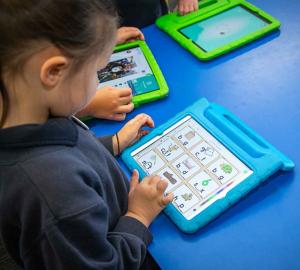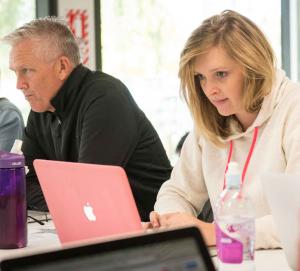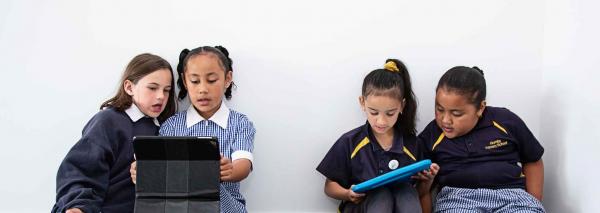Why this theme is important from an educational perspective
We are in a new decade and the pace of change driven by new technologies and technological advancements looks set to continue, even to accelerate rapidly like no other time in history. This will impact every aspect of how we live and work, with advancements across sectors such as health, energy, transport, industry, and how we interact with each other.

Key to understanding the significance of the technology theme in education is to consider the range of drivers that are evident at all levels, from government policy through to local school practices. These include:
- Digital literacy - ensuring our young people are equipped with the basic skills and knowledge required to make use of technology tools and applications.
- Digital citizenship - building on from digital literacy, but ensuring learners are also aware of their rights and responsibilities, and how to keep themselves safe as they navigate their way in a digital world.
- Curriculum support - supporting the work of educators through the provision of online curriculum content and curriculum specific applications and tools.
- Preparation for the future workforce - focusing specifically on developing the technological skills and capabilities required to contribute to the digitally-enabled workforce of the future.
- Supporting personalised learning - leveraging the affordances of technology to provide 1-1 support for learning, including timely feedback and next steps, suggestions, and a life-long personal record of learning.
- Expanding access to education - using technology to create virtual connections with learners and educators to bring a range of learning opportunities to the learner.
- Improving efficiency - reducing the administrative overhead on educators and educational leaders.
In every part of our lives technology is reshaping expectations and enabling new possibilities. Many of the emerging technologies are very different to what we have experienced in the past, requiring us to find new ways to adapt to digital change in more sustainable ways. This continuous and rapid change means that skills in the teaching workforce will need to be frequently adapted and upgraded.
New technologies like AI, machine learning and educational software aren’t just changing the field for learners. They’re also shaking up the role of educators, creating philosophical shifts in approaches to teaching, and remodelling learning spaces.
The important thing here is the pervasive nature of change that occurs when a new technology is introduced. Because technological change is not additive, it is ecological, when you add a new technology you don’t simply change something, you change everything.
Summary of the patterns and trends over the past 15 years
Digital technologies have been used in schools and early learning services for more than three decades now, starting with mainframe computers followed by desktops in computer labs, which were then moved into classrooms. What followed was the desktops being replaced by laptops and more recently by tablets and mobile phones. The shift in ownership of tablets and mobile phones, and what is done with them, reflects the changes across all areas of our education system towards a more personalised, learner-centred approach.
In the past 15 years the trends we’ve identified have seen developments with technology in the following areas that have had, and continue to have, significant impact on education:
- Personal, mobile devices. The release of the first iPhone in 2007 marked the beginning of a revolution in how we engage with, and the expectations we have of technology. The iPhone provided an entirely new human interface with the technology - touch, that has continued to develop with voice and gestures adding to the ways we can now interface with the technology. Each of these developments provides powerful new ways for learners to interact with their device - catering for the needs of learners who approach that differently, for example, the visually impaired.
It is important to appreciate the implications for the learner who is now able to own and manage their own device, and to have it available to access, manipulate and share information when and where they need. - Social media. Unsurprisingly, many of the major social media platforms we are now familiar with emerged around the same time as the iPhone (Twitter, Facebook, LinkedIn, etc). These sites provide individuals the opportunity to create their own environments and connections. They enable the shift from being consumers of information online to being creators who can contribute ideas and content across an increasingly wide range of platforms. The shifts in behaviour driven by social media are adding to the pressures on education centres and educators to rethink how they think about knowledge and learning, the role of teachers and the ways in which learners learn.
- Advanced networks. The government initiative to provide high speed internet access nationwide across Aotearoa New Zealand began in earnest in 2010, with all but a handful of the most remote learning settings now connected. This high speed access has ensured that the demand for bandwidth from large populations of students and teachers in a school/kura setting is met. They are able to access the online services and resources required to support their learning without the frustration of lengthy delays and interrupted service. The advent of advanced networks for schools/kura also marked the decision by many to move their servers off-site to more secure, commercially hosted locations. This removed the need to maintain expensive server hardware onsite, together with the challenge of managing and maintaining it.
- The cloud. The move to a cloud-based architecture for learning settings, as opposed to a designated server, is another of the most significant shifts in recent years. A cloud-based architecture has the advantage of being less susceptible in cases of server failure, as the information is distributed and replicated across the cloud infrastructure. It also means that instead of investing in specific software packages, individuals and organisations are able to subscribe to the software as a service (SaaS), with all of the updates and improvements to the software being provided as a part of the service. Other benefits of the cloud architecture are the opportunities for greater levels of integration, data interoperability, and collaboration with other services and platforms, providing a more ubiquitous experience for the user.
Examples of impact and consequences

The examples of how technology is impacting education and the consequences are myriad, so instead of trying to cover the field here we’ve chosen to focus on some of the things that we believe represent the big ideas and drivers for the future.
First up, as digital technologies have become more ubiquitous and a part of our everyday life, the United Nations declared that internet access is a fundamental human right in 2011. This has led to a focus on the provision of equitable access that has included projects to address a range of concerns about the digital divide, including BYOD, home access, device lease programmes, internet in libraries and public spaces, and the provision of open education resources.
Being a part of a digitally-enabled future means that every citizen must have the access and capabilities to participate in this way. This in turn creates a driver for learning settings to ensure that they are not only providing opportunities for learners to learn about all things digital, but that they themselves are operating as digital-enabled organisations. For example, Haeata Community Campus in Christchurch considers the expansion of internet access to enable students to use their devices to access their learning at home and at school at the same fast, safe and uncapped rate, to be a game changer for how they operate.
The concept of what a computer is has changed markedly over the past decade or so, with mobility being a key factor here, along with the touch interface these devices afford. The release of the Apple iPhone in 2007 heralded a new wave of mobile and touch technologies that have now become commonplace. This combination of mobility and intuitive user interface has completely altered so much of our human experience and expectations of what we can do with these technologies. In her CORE EDtalks video: Tara Fagan describes some of the benefits of using mobile devices, and challenges educators to reflect on how they are used, not only for teaching, but for children's learning. In his article on the future of mobile learning and implications for education and training David Parsons from Digital Promise provides a well-researched review of the promise, challenges and dangers of the future of mobile learning.

Of course, with all of the benefits has also come the risks. We have seen a steady increase of focus on things such as the protection of our digital identity, online privacy and data security, as well as an increase in the incidence of cyber-bullying, screen addiction and online crime. Keeping our learners safe has long been a focus of organisations such as NetSafe, which offers some valuable advice, but the real responsibilities lies at the local level with teachers, parents and the wider community, to ensure that our young people are well educated in how to make wise decisions about their use of digital devices. Many of these things are new for educators as well, so should be a part of a well informed and designed induction and professional learning programme.
As highlighted above, the ability of mobile devices to offer high level performance is a result of the shift from applications and resources being stored on the device, to being stored in ‘the cloud’ - that vast network of storage capability that enables truly ubiquitous access. Southland Girls’ High School provides a useful example of how cloud-based solutions are being used for communication and collaboration in their school.
This ubiquitous access has enabled further transformations in the way education settings operate, particularly in the way they are able to interact with their communities. The rapid rise of real-time reporting as an alternative to the traditional six-monthly approaches is a good example here. Platforms such as SeeSaw, Educa, Storypark and Linc-Ed Hero provide easy to use ways of making family/whānau a part of learning. The benefits of this have been confirmed by the Education Review Office whose research shows that parent-school partnerships are key to increasing achievement.
In educational settings we’ve seen an uptake of things such as 3Dprinting. Learners are exploring this technology’s ultimate ability to mass customise and conveniently produce just-in-time virtually all of the objects we need to operate our businesses. For example, Te Kura Kaupapa Māori o Te Waiū o Ngāti Porou created protective face masks for frontline health workers in local medical centres and hospitals during the Covid-19 lockdown.

The focus on Artificial Intelligence (AI) began to appear in our education settings and classrooms more recently, but interest is growing steadily. Now and in the future AI will play a pivotal role in teaching and learning across a range of education organisations. Children and young people will be able to learn through AI systems with adaptive software that can personalise their learning opportunity, for example, it will be able to respond to specific questions and discussion. We have a company in Aotearoa New Zealand, Soul Machines, which is already trialling their AI with students. Another example here is Amy, the online maths tutor. On first exposure Amy may seem to be a simple drill and practice application, but it is actually a very powerful, AI-driven tutoring system that learns from the way you interact with it and uses that information to personalise how it teaches you based on the specific ways you tackle the problems set for you.
AI will join the field of virtual and mixed reality platforms, creating a powerful combination of immersive user experience. Both virtual reality (VR) and augmented reality (AR) are now being used in many gaming platforms. The promise of these technologies has yet to be fully realised in education, but it is clear that advances in these areas will see them become a major part of the future of user experience. Nick Babich of Adobe Xd Ideas suggests that in the era of digital devices, we have an opportunity to enable better learning with technology. Virtual Reality (VR) seems to be the natural next step for the evolution of education. This view is supported by Professor Jeremy Bailenson from the Stanford Graduate School of Education, who suggests that virtual reality offers a captivating way to learn - in the classroom and beyond. An example from closer to home of this thinking being used in practice can be seen in Journeys of Manu - Maramataka. It involves developing platforms for indigenous story-telling and sharing mātauranga Māori (Māori sources of knowledge).
While AI in education is still in the emergent phase, exploring the goals around the intended use of AI is a conversation worth having now for educators, learners and their whānau in all settings.
What might we see moving forward into the future?
Looking ahead to the next ten or so years it would be unwise to try and predict what we may see in terms of specific technological advances. However, our monitoring of the trends and patterns in this area over the past 15 years suggests that whatever may emerge will likely demonstrate the following characteristics:
- Personalised - Technology will continue to empower individuals to be more in control of their learning, including what, where and when they learn, as well with whom they learn. Personalised learning platforms are likely to develop further, and be designed to interact at a very user-centric level with the user as they navigate through their learning journey. It is worth noting that personal identity and access management will remain a concern in achieving these goals.
- Ubiquitous - The concept of learning anywhere, anytime and with anyone is likely to become more dominant, presenting challenges to the existing structures of our organisations. Ubiquitous access to knowledge has already changed the role of schools, from being the place where you need to go to access knowledge, to learning what to do with it and being a part of a knowledge-building community. Location-awareness is likely to evolve further as a part of many services, giving rise to concerns about privacy and safety.
- Intelligent - The rise of Artificial Intelligence (AI) will infuse all areas of the digital services we find ourselves accessing. This includes awareness of the user’s location and matching responses with the learner’s personal profile, for example. While we look on at the development of things like self-driving cars, we need to be aware of the potential impact of AI at every level of what we currently do in our organisations. Fear of machines taking over will become an issue, with a renewed focus on the notion of "What makes us human?" becoming prevalent.
- Interoperability - Only recently have the systems and services we use begun to provide a more seamless user experience as we switch between one and another. Data stored in one system is still not automatically available within another, and our identity doesn't always translate, so we still need to use multiple passwords to log in. System and data interoperability is likely to be a key area of development into the next decade. Concerns about data integrity and ownership will remain a focus.
- Sustainability - The issue of ensuring our technology use is based on principles of sustainability will become a focus moving forward. Concerns about the amount of e-waste are being expressed as we have fallen victim to a consumer driven approach to our purchases and use of digital technologies. Consideration about how technology may be a part of the solution, instead of simply part of the problem, will become increasingly important in investment decisions at a national and local level.

-
Resources
Some books you may enjoy reading
- Thomas Friedman (2018) Thank You For Being Late; An optimist’s guide to thriving in the age of accelerations.
- Nicholas Negroponte (1995) Being Digital.
- Byron Reese(2018) The Fourth Age.
- Martin Ford(2015) The Rise of The Robots.
- Richard Watson (2016) Digital vs Human: how we’ll live, love and think into the future.
- Professor Antwi Akom (2020) Creating Equitable Neighbourhoods
Other resources
- Website: Singularity University
- TED Talk: Ray Kurzweil - the accelerating power of technology
- Kia Eke Panuku: Mātauranga Māori
- An interview with Keri Facer author of Learning Futures: Education, Technology, and Social Change
- Retooling School - Russell Burt
-
Examples in Practice
- BYOD supporting inclusion - Ben Britton, Wellington High School